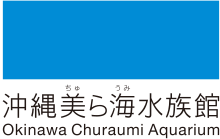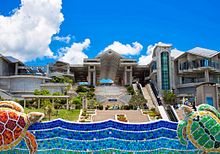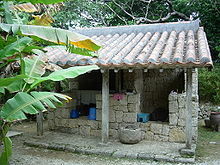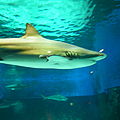Okinawa Churaumi Aquarium
This article may require copy editing for grammar, style, cohesion, tone, or spelling. (June 2021) |
 | |
 | |
| Date opened | 1 November 2002 [1] |
|---|---|
| Location | Motobu, Okinawa, Japan |
| Coordinates | 26°41′40″N 127°52′41″E / 26.69439°N 127.87794°ECoordinates: 26°41′40″N 127°52′41″E / 26.69439°N 127.87794°E |
| Land area | 19,000 m2 (200,000 sq ft) [1] |
| No. of animals | 11,000[2] |
| No. of species | 720[2] |
| Volume of largest tank | 7,500,000 litres (1,981,000 US gal) [3] |
| Total volume of tanks | 10,000,000 litres (2,642,000 US gal)[4] |
| Annual visitors | 3.5 million + [5][1] |
| Memberships | JAZA[6] |
| Major exhibits | The Kuroshio Sea tank Shark Research Lab Okichan Theater |
| Management | Okinawa Churashima Foundation |
| Website | oki-churaumi |
The Okinawa Churaumi Aquarium (沖縄美ら海水族館, Okinawa Churaumi Suizokukan) formerly Okinawa Ocean Expo Aquarium is located within the Ocean Expo Park in Okinawa, Japan. It welcomed its 50 millionth visitor on 29 June 2019 [7][5] and is a member of the Japanese Association of Zoos and Aquariums (JAZA). It was the largest aquarium in the world until it was surpassed by the Georgia Aquarium in 2005. The aquarium has the theme of “Encounter the Okinawan Sea”.[8] The sea of Okinawa is reproduced, and most of the creatures that are bred are species that live in the Okinawan Sea.[2] "Churaumi" was selected as the name of the aquarium by public vote amongst Japanese people. "Chura" means "beautiful" or "graceful" in the Okinawan language, and "umi" means "ocean" in Japanese.
History[]

In 1975, the World's Exposition or World's Fair was held in Okinawa, Japan at the Ocean Expo Park. At World's Exposition, an aquarium centered on marine life was exhibited.
In 1976, after the expo, the Okinawa Ocean Expo Aquarium was established as a national park on the site of the venue.
The Okinawa Ocean Expo Aquarium and the Okichan Theater at that time started operations by inheriting the facilities used at the Expo. At that time, the largest Maintank in the aquarium had a water volume of 1,100,000 litres (291,000 US gal), which was the largest in the world.[9]
The Okinawa Ocean Expo Aquarium is one of the first public aquariums in the world that breeds large sharks and rays such as whale sharks and manta rays.[9] At a symposium held in Baltimore in 1985, the Okinawa Ocean Expo Aquarium was rated as the most advanced breeding technology in the world for long-term rearing For 1 year and 9 months and exhibition of whale sharks, and for sharks and rays breeding rates.[9] In 1988, Okinawa Ocean Expo Aquarium won first The Koga Award from JAZA in Japan for breeding two generations in a whitetip reef shark.[10]
Afterward, the park began to lose tourism and it was believed that a new aquarium would help revive the area and celebrate Okinawa's marine tradition. In addition, since the facility was built for a short-term exposition, it has deteriorated significantly, so a plan to build a new aquarium was proposed.[4]
The Okinawa Ocean Expo Aquarium Aquarium was closed in August 2002 due to the deterioration of the facility, and the Okinawa Churaumi Aquarium was opened on November 1, 2002, with a new facility designed by YukiFusa Kokuba. The number of visitors in the year before the closing of the old building was about 430,000, but the number of visitors in the year after the opening of the new building increased sharply to 2.75 million.[11] The number of visitors has continued to increase since then, with the number of visitors reaching 3,784,132 in 2017 and the cumulative number of visitors reaching 50 million in 2019.[5]
In 2020, the number of tourists in Okinawa Prefecture decreased significantly due to the influence of COVID-19, and it became the first deficit[disambiguation needed] management since the opening of the new building in 2002.[12]
Aquarium[]
The public aquarium is a part of the Ocean Expo Park located in Motobu, Okinawa. The aquarium is made up of four floors, with tanks containing deep sea creatures, sharks, coral and tropical fish. The aquarium is set on 19,000 m2 of land, with a total of 77 tanks containing 10,000 m3 of water. Water for the saltwater exhibits is pumped into the aquarium from a source 350 m offshore, 24 hours a day.[13]
The Kuroshio Sea[]
The main tank, called the Kuroshio Sea, is 35 metres (115 ft) long, 27 metres (89 ft) wide and 10 metres (33 ft) deep.[14] It holds 7,500,000 litres (1,981,000 US gal) of water and features an acrylic glass panel measuring 8.2 by 22.5 metres (27 by 74 ft) with a thickness of 60 centimetres (2 ft),[15] the largest such panel in the world when the aquarium was opened.[3][16] In addition, the backyard of the Kuroshio Sea Tank has time to open, so you can observe the water from above the tank.[17]
Whale sharks and manta rays are kept alongside many other fish species in the main tank.[3] Since 2015, aquarium also have a melanistic reef manta ray with a black body.[18] The world's first birth of a manta ray in captivity was at the aquarium in 2007 and involved the reef manta ray (this species and the giant oceanic manta ray were only recognized as separate species in 2009, meaning that all were listed as Manta birostris until then).[19][20][21] By the time mother manta ray died in 2013, seven puppies were born and four survived.[22][23][24][25]
In addition, at the Okinawa Churaumi Aquarium, there is a record that the male reef manta ray, which started captivity in 1992 at its predecessor, the Okinawa Ocean Expo Aquarium, lived for about 23 years.[26]
Since 2018 they also keep Giant oceanic manta ray and Smoothtail devil ray.[27][28] In 2019, Giant oceanic manta ray was not exhibited in the main tank because it became ill and was moved to another tank for treatment, but it has fully recovered and has been bred again in the Kuroshio Sea main tank since may 2020 I will.[29][30]
The first attempt of keeping whale sharks in an aquarium was in 1980 by the Okinawa Ocean Expo Aquarium, the predecessor of the Churaumi Aquarium, and it remains one of the few aquariums that maintains the species.[31] Most were obtained from incidental catches in coastal nets set by fishers (none after 2009), but two were strandings. Several of these were already weak from capture/stranding and some were released,[31] but initial survival rates were low.[32] After the initial difficulties in maintaining the species had been resolved, some have survived long-term in captivity. The record for a whale shark in captivity is an individual that, as of 2021, has lived for more than 26 years in the Okinawa Churaumi Aquarium from Okinawa Ocean Expo Aquarium.[33]
Okinawa Churaumi is trying to breed whale sharks in captivity, which has never been achieved by an aquarium. Their oldest male reached sexual maturity around 2012 and began to show an interest in females in 2014. The exhibited until 2021 female was on display [34](another is maintained offshow) is 8 m (26 ft) long and expected to reach sexual maturity when 9 m (30 ft).[35] There used to be three whale sharks, but they have been moved to a separate tank to make room for breeding.[36] In 2021, a 13-year-old female whale shark that had been in captivity in the Kuroshio Sea tank was transferred to a medical treatment tank in the sea due to poor health, and later died. The cause of death is thought to be that feeding became difficult due to skeletal abnormalities in the jaw, and that the pylorus was twisted.[37][34]
The Coral Sea[]
In the "The Coral Sea" tank, 450 colonies of reef-building corals of about 80 species are bred and exhibited.[38] The tank with a capacity of 300,000 litres (79,000 US gal) has no roof and has a structure that allows strong sunlight to enter, and the constant supply of fresh seawater enables large-scale breeding of coral. The "The Coral Sea" tank is made with reference to the actual scenery of the coral reefs in Motobu.[38]
There are many corals in the tank that have been growing for more than 10 years since the opening of the public aquarium.[38] The tank holds 80 species of coral. Their corals have spawned every year at the aquarium since 2002.[39] In 2021, the Okinawa Churaumi Aquarium was temporarily closed due to the influence of the COVID-19, so it was not open to the public, but it was confirmed that Acropora microphthalma gave spawned in the daytime for the first time at the Okinawa Churaumi Aquarium.[40]
The Shark Research Lab[]
Sharks such as bull sharks, tiger sharks, silvertip sharks and silky sharks are bred in the shark research lab tank. Some bull sharks kept in aquariums have lived for more than 42 years.[33]
In 2016, the aquarium showed an attempt to raise an adult great white shark. The great white shark exhibit was successful, but died three days later, leading to criticism from animal rights groups.[41] In 2019, aquariums captured a pregnant tiger shark and succeeded in giving birth in a shark research lab tank.[42]
Facilities[]
The facility has four floors and is designed so that the sea in the exhibition tank gets deeper as you go downstairs. The exhibited creatures are open to the public at "Churaumi Official Fish Encyclopedia".
4F Invitation to the Great Sea[]
- Whale Shark Sculpture
- Uminchu Gate
- The Coral Sea Upper side
- The Sea of Tropical Fish Upper side
- Inoh restaurant
- Event Hall
3F Coral Reef Gallery[]
- Life in the “inoh”
- The Coral Sea
- The Sea of Tropical Fish
- Coral Reef World
- Coral Reef Gallery
2F Journey to the Kuroshio[]
- Churaumi Theater
- Shark Research Lab
- The Kuroshio Sea (Main tank)
- Exploring the Kuroshio Sea tank (observation course above the water)
- Whale Shark & Manta Ray Corner
- Aqua Room
- Café “Ocean Blue”
1F Journey into the Deep Sea[]
- Deep Sea World
- Deep Sea Experience Room
- Small Life in the Deep Sea
- Deep Sea
- Ocean Planetarium
- Aqua Lab
- Area Around the Exit
- Ryukyu Arc Riverside
Okichan Theater and Dolphin Lagoon[]

Near the aquarium is the Dolphin Show Stadium, called the Okichan Theater, where viewers can touch and watch the show's performance for free.[47] Also, There is also a dolphin contact facility called Dolphin Lagoon. They are bottlenose dolphin and Indo-Pacific bottlenose dolphin and Pacific white-sided dolphin and false killer whale and Pantropical spotted dolphin and Rough-toothed dolphin and Pygmy killer whale.[48][49] The Indo-Pacific bottlenose dolphin named Okichan has been owned since the opening of the Okinawa Ocean Expo Aquarium and has been bred for 45 years as of 2020.[33]
In 2003, at the Okichan Theater, 75% of the bottlenose dolphin named Fuji caudal fin was necrotic and resected. Therefore, Okinawa Churaumi Aquarium, in collaboration with Bridgestone, has developed the world's first artificial caudal fin and started a project to attach it to Fuji.[50][51][52] Initially, it could not be installed well because it could not withstand the swimming of dolphins, but after many improvements, aquarium succeeded in installing an artificial tail fin on the dolphin.[9] Fuji died of infectious hepatitis in 2014 at an estimated age of 45.[53]
Other activities[]

There is also a manatee exhibition featuring manatees given to the aquarium by the Mexican government and a sea turtle exhibition.[54][55] A spawning ground has been set up in the exhibition facility dedicated to sea turtles, and in the past it has succeeded in spawning Hawksbill sea turtle, Loggerhead sea turtle, and Green sea turtle.[56] Aquariums also succeeded in giving birth to West Indian manatees.[57] In addition, a video of a manatee giving birth in captivity in 2003 is being shown at the manatee exhibition facility.[58]
In addition, Churaumi Plaza, which is a public resting place Free opening to the public, has a museum displaying specimens Megamouth Shark, humpback whale research data, artificial tail fins of dolphins, etc. And there is a souvenir corner.[59]
There is also Emerald Beach which is accessible by the 200 yen tram.[60] Every year at Emerald Beach, wild turtles are confirmed to spawn.[61] Ocean Expo Park which holds the aquarium also has a selection of other activities. A native Okinawan Museum, Oceanic Culture Museum, Tropical Dream Center, and a Tropical & Subtropical Arboretum to a historic village.[3]
Research and conservation[]

At the Churaumi Aquarium, the Okinawa Churashima Foundation supervises conservation activities and conducts research on animals.[10] aquariums engaged in activities to return the results to the protection and cultivation of living things and the conservation of biodiversity. Okinawa Churaumi Aquarium has won the breeding award from JAZA for 26 kinds of animals such as Reef manta ray and Indo-Pacific bottlenose dolphin.[10] In particular, it is characterized by the large breeding of large sharks and rays, which are rare in other buildings.
At the Churaumi Aquarium, aquariums currently collecting blood from wild whale sharks, measuring the total length and circumference of the body, collecting tissues for DNA analysis and chemical analysis, and observing behavior in the natural sea using electronic labels.[10] Aquariums are conducting these studies to obtain important information on the breeding and ecology of whale sharks. aquariums also conducting surveys for future breeding, such as monitoring the behavior of whale sharks during breeding and the concentration of hormones in the blood obtained by Blood sampling.[10]
In addition, aquariums are conducting research on the diversity of marine life found around Okinawa and ecological characteristics, and are engaged in activities that contribute to the conservation and sustainable use of the natural environment.[62] aquariums mainly investigating marine life such as many other papers have been published. The research activities of marine life are summarized on the official website. Research and conservation, annual activity history, etc. will be reported in the annual report.[63]
Okinawa Churaumi Aquarium is investigating many humpback whales in cooperation with local people and domestic and foreign researchers.[64] In a joint survey with Philippines in 2021, it was also revealed that 43.48% of the humpback whales around the Philippines were in agreement with the individuals confirmed in Okinawa and were moving between the two waters.[65] This revealed the migration route of humpback whales between Okinawa and the Philippines from the previously unknown Russia feeding ground.[65]
Okinawa Churaumi Aquariums are also working to protect nature, including the rescue of debilitated animals, reintroduction to the wild, and release of rare species bred in captivity. Tags are attached to the released creatures and used to investigate behavioral routes.[66]
In addition, aquariums providing animal welfare to improve QOL by improving the breeding environment such as feed, breeding facilities, animal health and safety, and increasing opportunities such as animal comfort and joy, interest and satisfaction. aquariums will create a better breeding environment for breeding animals through three-stage inspections including external surveys and welfare evaluations.[67]
As a research institute, the Public aquarium also contributes to the discovery of new species of marine life. New species discovered in the past include Eumunida balteipes,[68] Hexagonaloides bathyalis,[69] and Synactinernus churaumi, a new species of sea anemone that has been studied for over 15 years.[70]
Gallery[]
Exterior
Aquarium
Main tank aquarium
Okichan Theater
Sea turtle and manatees
See also[]
References[]
- ^ Jump up to: a b c "Comparison of major aquariums in the Greater Tokyo Area (Japanese)" (PDF).
- ^ Jump up to: a b c "よくある質問 どのくらいの数の生き物を飼っていますか?". 沖縄美ら海水族館. Retrieved 2021-05-07.
- ^ Jump up to: a b c d "Amazing Engineering: the Okinawa Churaumi Aquarium". wayfaring.info. Wayfaring Travel Guide. 21 June 2007. Archived from the original on 9 July 2010. Retrieved 3 August 2010.
- ^ Jump up to: a b "施設概要 沖縄美ら海水族館". 沖縄美ら海水族館. Retrieved 2021-05-07.
- ^ Jump up to: a b c 国営沖縄記念公園事務所-利用者状況 内閣府沖縄総合事務局 2021-05-07
- ^ "List of Aquariums" (PDF). jazga.or.jp. Japanese Association of Zoos and Aquariums. Retrieved 12 June 2010.[permanent dead link]
- ^ "We are pleased to have received the 20 millionth visitor!!". oki-churaumi.jp. Okinawa Churaumi Aquarium. Archived from the original on 2010-06-09. Retrieved 3 August 2010.
- ^ "About Okinawa Churaumi Aquarium - Okinawa Travel Guide | Planetyze". Planetyze. Retrieved 2017-08-15.
- ^ Jump up to: a b c d 内田詮三 (2012). 沖縄美ら海水族館が日本一になった理由. 光文社新書.
- ^ Jump up to: a b c d e "Breeding in Captivity". Retrieved 2021-05-22.
- ^ 1.沖縄ブロックの現状と課題 2021-05-07
- ^ "沖縄美ら海水族館、開業以来初のマイナス収支 県に移管した7施設 4264万円の赤字". 沖縄タイムス. 2020-10-20. Retrieved 2021-05-07.
- ^ "Okinawa Churaumi Aquarium". oki-churaumi.jp. Okinawa Churaumi Aquarium. Archived from the original on 22 June 2013. Retrieved 3 August 2010.
- ^ "Archived copy". Archived from the original on 2015-09-11. Retrieved 2013-09-29.CS1 maint: archived copy as title (link)
- ^ "Welcome to Okinawa Churaumi Aquarium". oki-churaumi.jp. Okinawa Churaumi Aquarium. Retrieved 3 August 2010.
- ^ The size of this panel was surpassed in 2008 when a larger panel was installed in the Dubai Mall Aquarium
- ^ "Exploring the Kuroshio Sea tank (observation course above the water)".
- ^ "日本初!『ブラックマンタ』展示開始!". 2015-12-21. Retrieved 2021-04-17.
- ^ "3 Years in a row! This year too, a baby Manta was born in the Oki". oki-churaumi.jp. Okinawa Churaumi Aquarium. 6 July 2010. Archived from the original on 22 July 2011. Retrieved 3 August 2010.
- ^ Marshall, A. D.; Compagno, L. J. V.; Bennett, M. B. (2009). "Redescription of the genus Manta with resurrection of Manta alfredi (Krefft, 1868) (Chondrichthyes; Myliobatoidei; Mobulidae)". Zootaxa. 2301: 1–28. doi:10.11646/zootaxa.2301.1.1. ISSN 1175-5326.
- ^ Ryo Nozu; Kiyomi Murakumo; Rui Matsumoto; Yosuke Matsumoto; Nagisa Yano; Masaru Nakamura; Makio Yanagisawa; Keiichi Ueda; Keiichi Sato (2017). "High-resolution monitoring from birth to sexual maturity of a male reef manta ray, Mobula alfredi, held in captivity for 7 years: changes in external morphology, behavior, and steroid hormones levels". BMC Zoology. 2 (14). doi:10.1186/s40850-017-0023-0.
- ^ "We have just recently had our 4th successful manta ray (Manta birostris) birth in captivity at Okinawa Churaumi Aquarium". oki-churaumi.jp. Okinawa Churaumi Aquarium. 6 July 2010. Archived from the original on 22 July 2011. Retrieved 3 August 2010.
- ^ "平成22-23年度 沖縄美ら海水族館年報" (PDF). Okinawa Churaumi aquarium. Retrieved 2021-05-29.
- ^ "平成24年度 沖縄美ら海水族館年報" (PDF). Okinawa Churaumi aquarium. Retrieved 2021-05-29.
- ^ "平成25年度 沖縄美ら海水族館年報" (PDF). Okinawa Churaumi aquarium. Retrieved 2021-05-29.
- ^ "平成26年度 沖縄美ら海水族館年報" (PDF). Okinawa Churaumi aquarium. Retrieved 2021-05-29.
- ^ "The world's largest ray! The giant manta!". Okinawa Churaumi Aquarium. 2019-01-04. Archived from the original on 2019-01-06. Retrieved 2019-01-05.
- ^ "Small manta!? The world's first exhibit of smoothtail devil ray". Retrieved 2021-05-22.
- ^ "Exhibit of giant manta closed depending on the health condition". 2019-02-10. Retrieved 2021-04-17.
- ^ "Once again, a giant manta, the world's largest species of ray, is living in the Kuroshio Sea tank!". 2020-06-25. Retrieved 2021-04-17.
- ^ Jump up to: a b Matsumoto; Toda; Matsumoto; Ueda; Nakazato; Sato; and Uchida (2017). Smith; Warmolts; Thoney; Hueter; Murray; Ezcurra (eds.). Notes on Husbandry of Whale Sharks, Rhincodon typus, in Aquaria. Elasmobranch Husbandry Manual II. Special Publication of the Ohio Biological Survey. pp. 15–22. ISBN 978-0-86727-166-9.CS1 maint: uses authors parameter (link)
- ^ Goodman, Brenda (14 June 2007). "Georgia Aquarium Mourns Another of Its Whale Sharks". The New York Times. Retrieved 29 December 2018.
- ^ Jump up to: a b c "令和二年度 沖縄美ら海水族館 年報" (PDF). Okinawa Churaumi Aquarium. Retrieved 2021-05-28.
- ^ Jump up to: a b "美ら海水族館のジンベエザメ死ぬ 沖縄タイムス".
- ^ "Breeding in Captivity". Okinawa Churaumi Aquarium. Retrieved 29 December 2018.
- ^ "水族館の新しいこころみ!ジンベエザメの繁殖に向けた飼育展示について".
- ^ "Whale sharks in the Kuroshio Sea tank".
- ^ Jump up to: a b c "The Coral Sea". Okinawa churaumi aquarium.
- ^ "Churaumi Aquarium coral has spawned annually for 17 years! On June 12th 2018, we confirmed coral spawning had occurred in the Coral Sea tank!". Okinawa Churaumi Aquarium. 2018-06-14. Retrieved 2019-01-05.
- ^ "【動画あり】展示用サンゴで国内初 昼の産卵に美ら海水族館が成功 ピンクの粒が幻想的に舞い上がる". Okinawa times. Retrieved 2021-05-28.
- ^ "Great white shark dies after three days in captivity in Japan". The Guardian. 2016-01-08. Retrieved 2019-02-06.
- ^ "World's first! Tiger shark born in the aquarium.Exhibited now at the Shark Research Lab tank". 2019-07-01. Retrieved 2021-04-17.
- ^ "Invitation to the Great Sea". Okinawa churaumi aquarium.
- ^ "Coral Reef Gallery". Okinawa churaumi aquarium.
- ^ "Journey to the Kuroshio". Okinawa churaumi aquarium.
- ^ "Journey into the Deep Sea". Okinawa churaumi aquarium.
- ^ "Dolphin Show (Okichan Theater)". Okinawa churaumi aquarium. Retrieved 2021-05-22.
- ^ "オキちゃん劇場/イルカショー". Okinawa churaumi aquarium. Retrieved 2021-05-22.
- ^ "Pygmy killer whale". Churaumi Official Fish Encyclopedia. Retrieved 2021-05-22.
- ^ "A new beginning for Fuji the dolphin". 2007-09-15. Retrieved 2021-04-17.
- ^ "Fuji, the Bionic Dolphin With the Artificial Fin (video)". 2010-12-26. Retrieved 2021-04-17.
- ^ "Fuji The Dolphin's Rubber Tail". 2004-12-14. Retrieved 2021-04-17.
- ^ "Aged dolphin with artificial tail fin dies at Okinawa aquarium". Retrieved 2021-05-22.
- ^ "マナティー館". Retrieved 2021-04-23.
- ^ "Sea Turtle Pool". Retrieved 2021-04-23.
- ^ "The only place in the world exhibiting four different species of baby sea turtles!". Retrieved 2021-04-23.
- ^ "Dolphin Feeding Program / Turtle Feeding Program / Manatee Feeding Program". Okinawa churaumi aquarium.
- ^ "マナティー館 沖縄美ら海水族館". Okinawa churaumi aquarium. Retrieved 2021-05-22.
- ^ "総合休憩所 美ら海プラザ 沖縄美ら海水族館". Okinawa churaumi aquarium.
- ^ "水族館周辺エリア 沖縄美ら海水族館". Okinawa churaumi aquarium. Retrieved 2021-05-22.
- ^ "エメラルドビーチ 沖縄美ら海水族館". Okinawa churaumi aquarium. Retrieved 2021-05-22.
- ^ "Research publication and activity". Retrieved 2021-05-22.
- ^ "魚類等の生物多様性に関する調査研究". Retrieved 2021-05-22.
- ^ "Surveys of the humpback whale Research on marine organisms". Retrieved 2021-06-07.
- ^ Jump up to: a b "Interchange and movements of humpback whales (Megaptera novaeangliae) between western North Pacific winter breeding grounds in northern Luzon, Philippines and Okinawa, Japan". Retrieved 2021-06-07.
- ^ "希少生物保護の取り組みについて". Retrieved 2021-05-22.
- ^ "動物福祉評価について". Retrieved 2021-05-22.
- ^ "新種��見! 世界初「シマツノコシオリエビ」の展示を開始". Retrieved 2021-05-07.
- ^ "美ら海生き物図鑑 シンカイサンゴガニ". Retrieved 2021-05-22.
- ^ "新種発見!世界初「チュラウミカワリギンチャク」の展示を開始". Retrieved 2021-05-07.
External links[]
| Wikimedia Commons has media related to Okinawa Churaumi Aquarium. |
- Official website (Japanese)
- Official website (English)
- Churaumi Official Fish Encyclopedia(Japanese)
- Churaumi Official Fish Encyclopedia(English)
- Ocean Park Homepage in English
- Okinawa Churaumi Aquarium's channel on YouTube
- Okinawa Churaumi Aquarium on Facebook
- Okinawa Churaumi Aquarium on Twitter
- Okinawa Churaumi Aquarium on Instagram
- Bus Timetable from Asahibashi Sta. to the Aquarium
 Geographic data related to Okinawa Churaumi Aquarium at OpenStreetMap
Geographic data related to Okinawa Churaumi Aquarium at OpenStreetMap
- Aquaria in Japan
- Tourist attractions in Okinawa Prefecture
- 2002 establishments in Japan
- Buildings and structures in Okinawa Prefecture




























